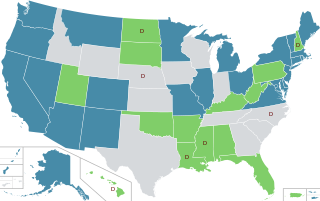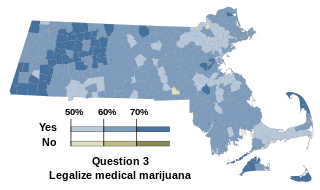
Proposition 215, or the Compassionate Use Act of 1996, is a California law allowing the use of medical cannabis despite marijuana's lack of the normal Food and Drug Administration testing for safety and efficacy. It was enacted, on November 5, 1996, by means of the initiative process, and passed with 5,382,915 (55.6%) votes in favor and 4,301,960 (44.4%) against.

The Marijuana Policy Project (MPP) is the largest organization working solely on marijuana policy reform in the United States in terms of its budget, number of members, and staff. Its stated aims are to: (1) increase public support for non-punitive, non-coercive marijuana policies; (2) identify and activate supporters of non-punitive, non-coercive marijuana policies; (3) change state laws to reduce or eliminate penalties for the medical and non-medical use of marijuana; and (4) gain influence in Congress. MPP advocates taxing and regulating the possession and sale of marijuana in a manner similar to alcohol, envisions a nation where marijuana education is honest and realistic, and believes treatment for problem marijuana users should be non-coercive and geared toward reducing harm.

Steven Wynn "Steve" Kubby is a Libertarian Party activist who played a key role in the drafting and passage of California Proposition 215. The proposition was a ballot initiative to legalize medical marijuana which was approved by voters in 1996. Kubby himself is well known as a cancer patient who relies on medical cannabis. He has authored two books on drug policy reform: The Politics of Consciousness, and Why Marijuana Should Be Legal. He was the Libertarian Party of California candidate for Governor of California in 1998 receiving 0.9% of the vote. In 2008, he declared his candidacy for the Libertarian Party's 2008 presidential nomination and received significant support for the nomination, but was eliminated after the second ballot. Although various media reports have described him as a "felon" and "fugitive", Kubby's legal status was resolved on July 3, 2008, when California Superior Court Judge, David Nelson, dismissed all charges against Kubby, clearing his name and record of any criminal activity.

The Oregon Medical Marijuana Act, a law in the U.S. state of Oregon, was established by Oregon Ballot Measure 67 in 1998, passing with 54.6% support. It modified state law to allow the cultivation, possession, and use of marijuana by doctor recommendation for patients with certain medical conditions. The Act does not affect federal law, which still prohibits the cultivation and possession of marijuana.
Use of heroin peaked between 1969 and 1971, marijuana between 1978 and 1979, and cocaine between 1987 and 1989. A major decline in the use of opium started after the Harrison Act of 1914 was initiated.
Drug policy of California refers to the policy on various classes and kinds of drugs in the U.S. state of California. Cannabis possession has been decriminalized and is soon to be legalised following legislation changes, but its cultivation and sale remain criminal offenses, along with the possession, sale, and manufacture of harder drugs such as methamphetamine and cocaine. With respect to many controlled substances, terms such as illegal and prohibited do not include their authorized possession or sale as laid out by applicable laws.
The Michigan Compassionate Care Initiative was an indirect initiated state statute that allowed the medical use of marijuana for seriously ill patients. It was approved by voters as Proposal 1 on November 6, 2008, 63 percent in favor to 37 percent opposed.

Cannabis in Oregon relates to a number of legislative, legal, and cultural events surrounding use of cannabis. Oregon was the first U.S. state to decriminalize the possession of small amounts of cannabis, and among the first to authorize its use for medical purposes. An attempt to recriminalize possession of small amounts of cannabis was turned down by Oregon voters in 1997.

In the United States, the use of cannabis for medical purposes is legal in 33 states, four permanently inhabited U.S. territories, and the District of Columbia, as of January 2019. Fourteen other states have more restrictive laws limiting THC content, for the purpose of allowing access to products that are rich in cannabidiol (CBD), a non-psychoactive component of cannabis. There is considerable variation in medical cannabis laws from state to state, including how it is produced and distributed, how it can be consumed, and what medical conditions it can be used for.

Cannabis in California is legal for both medical and recreational use. In recent decades, the state has been at the forefront of efforts to reform cannabis laws, beginning in 1972 with the nation's first ballot initiative attempting to legalize cannabis. Although Proposition 19 was unsuccessful, California would later become the first state to legalize medical cannabis with the passage of the Compassionate Use Act of 1996. In November 2016, California voters approved the Adult Use of Marijuana Act to legalize the recreational use of cannabis.

California Proposition 19 was a ballot initiative on the November 2, 2010 statewide ballot. It was defeated, with 53.5% of California voters voting "No" and 46.5% voting "Yes." If passed, it would have legalized various marijuana-related activities, allowed local governments to regulate these activities, permitted local governments to impose and collect marijuana-related fees and taxes, and authorized various criminal and civil penalties. In March 2010, it qualified to be on the November statewide ballot. The proposition required a simple majority in order to pass, and would have taken effect the day after the election. Yes on 19 was the official advocacy group for the initiative and California Public Safety Institute: No On Proposition 19 was the official opposition group.

In the United States, the use and possession of cannabis is illegal under federal law for any purpose, by way of the Controlled Substances Act of 1970. Under the CSA, cannabis is classified as a Schedule I substance, determined to have a high potential for abuse and no accepted medical use – thereby prohibiting even medical use of the drug. At the state level, however, policies regarding the medical and recreational use of cannabis vary greatly, and in many states conflict significantly with federal law.

The Massachusetts Medical Marijuana Initiative, appeared as the third question on the state's 2012 ballot as an indirect initiated state statute. The measure allows cannabis to be used for medical purposes in the state. The initiative—backed by the American Civil Liberties Union, the Massachusetts Patient Advocacy Alliance, and the Committee for Compassionate Medicine—was filed with proponents turning in the required signatures to the Massachusetts Attorney General's office by the August 3, 2011 deadline. Those signatures were needed for the required ten qualified voters who submitted the original petition to put forward the full text of the law they want enacted. The initiative passed with support from 63% of state voters.

The legal history of cannabis in the United States began with state-level prohibition in the early 20th century, with the first major federal limitations occurring in 1937. Starting with Oregon in 1973, individual states began to liberalize cannabis laws through decriminalization. In 1996, California became the first state to legalize medical cannabis, sparking a trend that spread to a majority of states by 2016. In 2012, Colorado and Washington became the first states to legalize cannabis for recreational use.
Cannabis in North Dakota concerns the drug cannabis in North Dakota, United States, where cannabis was legalized for medical purposes in 2016 but remains illegal for recreational purposes. Possession of small recreational amounts is a misdemeanor crime. The cultivation of hemp is currently legal in North Dakota. In November 2018, the state's voters voted on recreational marijuana legalization, along with Michigan; the measure was rejected 59% to 41%.

The Adult Use of Marijuana Act (AUMA) was a 2016 voter initiative to legalize cannabis in California. The full name is the Control, Regulate and Tax Adult Use of Marijuana Act. The initiative passed with 57% voter approval and became law on November 9, 2016, leading to recreational cannabis sales in California by January 2018.

Cannabis in Nevada became legal for recreational use effective January 1, 2017, having been legalized by ballot initiative in 2016. Medical marijuana use was legalized by ballot initiative in 2000, and has been available to licensed individuals in the state since shortly after that date. Nevada also licenses growers and distributors, and citizens of Nevada are banned from growing their own cannabis unless they live more than 25 miles from a licensed dispensary.

Cannabis in Arizona is legal for medical uses, but prohibited for recreational use.
Cannabis in Michigan is legal for medical use and recreational use, after passing a ballot initiative in 2018. Regulated stores are expected to open early in 2020.














